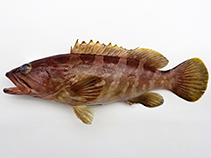| Family: |
Epinephelidae (Groupers) |
| Max. size: |
136 cm TL (male/unsexed); max.weight: 33 kg |
| Environment: |
reef-associated; marine; depth range 20 - 200 m |
| Distribution: |
Northwest Pacific: Korea, Japan (north to Hegura-jima Island), China (south to Hong Kong and Hainan Island), and Taiwan. |
| Diagnosis: |
Dorsal spines (total): 11-11; Dorsal soft rays (total): 13-15; Anal spines: 3-3; Anal soft rays: 8-8. Distinguished by the following characteristics: adults dark greyish brown; body covered with small pale grey spots forming short horizontal lines and mottled pattern; lower margin of the anal fin and lower corner of the caudal fin with white edge; juveniles pale yellowish brown, body with 6 irregular oblique dark bars containing irregular pale spots; elongate body, depth 3.0-3.6 times in SL; head length 2.3-2.5 in SL; convex interorbital area; angular preopercle, serrae at angle distinctly enlarged; inconspicuous dorsal spine on opercle; convex upper edge of operculum; small and subequal posterior and anterior nostrils; maxilla reaching past vertical at rear edge of eye, tiny embedded scales on maxilla; absence of step on ventral edge of maxilla; 2 rows of well-developed canines on midlateral part of lower jaw; caudal fin rounded; mid-lateral body scales ctenoid, without auxiliary scales on body (Ref. 089707). |
| Biology: |
Inhabits rocky reefs; also found on muddy grounds (Ref. 089707). Juveniles occur in shallow waters. Commercially cultured in Japan. |
| IUCN Red List Status: |
Vulnerable (VU); Date assessed: 20 November 2016 (A2bd) Ref. (130435)
|
| Threat to humans: |
harmless |
Source and more info: www.fishbase.org. For personal, classroom, and other internal use only. Not for publication.
